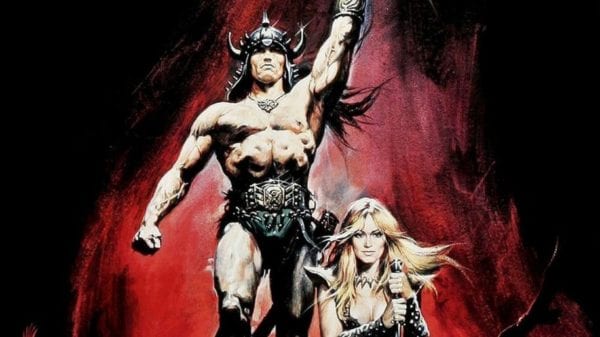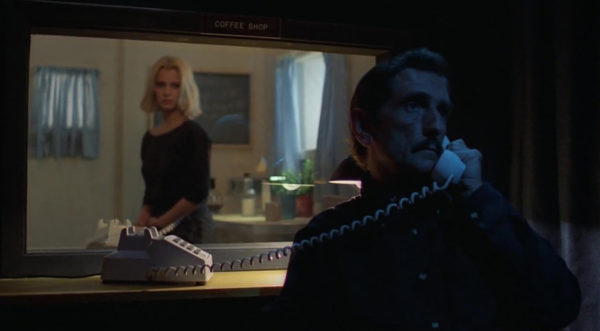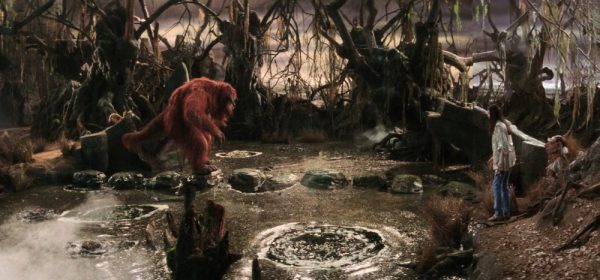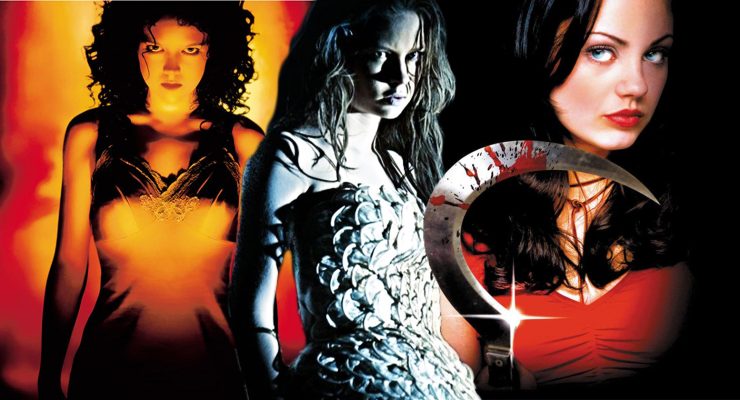Tom Jolliffe offers up 15 great cinematic journeys…

When it comes to cinema, the very best films will grab the audience and keep us gripped throughout the runtime. Every character goes on a particular journey that can be literal and/or metaphorical. Those literal epic journeys which might see hobbits on a quest to take a ring to a volcano make for particularly enthralling stories.
It usually goes, that a protagonist (or several) steps out of their comfort zone, into lands foreign to them, and usually hostile (because we need some conflict). That journey outward becomes a simultaneous journey inward, as they must find a kind of strength or clarity from within. Cinema has certainly been filled with many great examples of arduous, life affirming journeys. Here are a few:
Conan The Barbarian

Long arduous journey you say? Well how about nigh on twenty years, much of which is spent bound in slavery, before being untethered to roam across dangerous lands? Why? Well Conan asks only one thing from Crom, “Grant me this one request…Grant me revenge…and if you do nahht listen den to hell wid you!!” So it’s a determined, focused trek from adolescence to being a young barbarian behemoth, in search of Thulsa Doom, who murdered Conan’s parents. An unshakable focus on vengeance.
John Milius’ sorely underrated and grandiose operatic fantasy is quite unlike the very many sword and sorceries that rode on its loincloth-tails in the 80’s. This is a bonafide masterwork allowing its imperious musical score to tell the story in a film sparse on dialogue. It looks glorious, the weight of Conan’s quest and journey which transcends beyond the mortal realm, and sees him fall in love in the process too, is truly epic. It’s just head and shoulders above everything else in its sub-genre and Arnold is perfectly cast. The movie is stolen however by Sandahl Bergman who is stunning, whilst James Earl Jones is a great villain.
Stalker

Andrei Tarkovsky’s sci-fi masterpiece is laden with pondering philosophy and reflection. An amalgamation of some of the characters also seem to deeply reflect his own personality (the ‘Writer’ in particular). Not for the first or last time in his career, Tarkovsky crafts an introspective journey, layered beneath a ‘quest.’ His very distinct approach to visual storytelling and wilfully slow pacing also makes you feel the passing seconds. Once you’re engrossed and ‘present’ in the story, you are then essentially involved in the journey, quite unlike anything else cinema can offer.
As the Stalker, Writer and Professor journey to ‘the zone’ they encounter undefined dangers which may or may not be real. Tarkovsky’s earthy frames are filled with natural detail, rich in texture and another aspect that makes you feel the journey. Ultimately whilst the three protagonists meander to a place where their deepest desires could come true, it’s that parallel inward journey that is even more interesting. Additionally the making of the film was a notoriously arduous quest. Trial by fire almost, having to be almost entirely reshot (after most of the initial footage was lost) and at a location so seeped in radioactivity, that it ultimately shortened the lifespan of many of the crew (who would later die of cancer in many cases).
The Lord of the Rings

Peter Jackson’s original trilogy. For a three year span, The Lord of the Rings became a must see Christmas event. In truth there’s been nothing during the season since which has had quite the same pull. Such was the epic scope of this story and the buzz, that it had audiences hooked in from the start, and made it essential to come back.
Frodo and friends journeying across middle Earth across 9 hours of cinema, never felt overlong from a viewing perspective, but certainly we felt the danger throughout. Jackson seemed to reinvigorate the blockbuster around this time, and his great blending of superb sets and practical work, with grandiose CGI was well balanced (whereas his Hobbit trilogy was a bit CGI heavy). Additionally he legitimised blockbuster cinema with well rounded characters (benefiting from the beefy run times). The films did particularly well at Oscar season considering the genre (Return of the King, the final instalment won Best Picture). Impeccable, engrossing filmmaking and it holds up brilliantly.
Paris, Texas

Wim Wenders with his quirky cinematic sensibilities was no stranger to road movies, making a number of great films in Europe. Paris, Texas would be the film which introduced him significantly to US audiences, and allowed him to cast his unique eye on a very distinct part of America. That alien eye gives a very classic American road movie a very interesting perspective, and that is further exemplified by Robby Muller’s stunning cinematography.
Southern states America becomes almost otherworldly and ethereal. It becomes occasionally a metaphorical landscape reflecting the inner turmoil and listlessness of our central character Travis (played by a never better, Harry Dean Stanton). He wonders out of the dessert, having been missing for years, presumed dead, with foggy memories of his previous life. He has a son he must reconnect with, and his brother, but the thought of his ex burns in his mind the more he returns to compos mentis. Then he journeys with his son to find her. It’s a long, reflective and slow burning movie but beautifully engaging with a subdued and laconic guitar score from Ry Cooder. It’s also beautifully written by Sam Shepard.
Planes, Trains and Automobiles

We’re in November now. Tis the season, the season for Planes, Trains and Automobiles. This is all about the journey, as uptight, successful businessmen Steve Martin is greeted with a non stop barrage of comical obstacles in his quest to get home for Thanksgiving. Many of the moments in this comedy of errors revolve around the travel companion he can’t quite shake, played wonderfully by John Candy.
There’s not much to say about how good this film is. It’s just one of the most endlessly repeatable, beautifully crafted comedies ever made. Martin and Candy are both on top form in what might be John Hughes’ masterwork. Achingly funny but also heartfelt and touching in the right places, perfectly encapsulating just how effortlessly affable Candy was as a performer. I watch it every year, and genuinely look forward to the now traditional seasonal viewing.
Saving Private Ryan

The war film had been in something of a rut across the 80’s and 90’s. There’d been a few standouts, not least Spielberg’s harrowing masterpiece, Schindler’s List. Saving Private Ryan seemed to kickstart a new wave, and nothing after quite matched up (besides The Thin Red Line which was so distinctly Malick).
Tom Hanks leads a small unit tasked with heading across war torn France, to find a Paratrooper called Private Ryan, whose brothers have been killed in action. It’s an astonishing cast absolutely loaded top to bottom with stars who flit in and out and give great performances. Hanks is sensational. Spielberg pulls no punches and his Omaha landing sequence is a technical, gut wrenching marvel. The film has become the benchmark by which all other war movies have since been compared. The journey through hostile territories is terse, chilling and nail-biting.
Labyrinth

Blending elements of The Wizard of Oz and Alice in Wonderland, Labyrinth tells the tale of young Sarah (Jennifer Connelly) who must journey through a wondrous but hazardous Goblin Kingdom to rescue her baby brother. An array of creatures are brought to life by Jim Henson in a world wonderfully crafted (entirely by sets).
Labyrinth can be seen very much on the surface as a family friendly musical fantasy, but also deeper as a darker tale of paranoid schizophrenia, as a young girl creates an internal delusion based on the literary, movie and musical stories she obsesses over, as well her toy characters (friends), her absent maternal mother and step-father (who is pictured in Sarah’s room, with Bowie in said frame). Sarah becomes her mother, the step-father becomes the Goblin King, as she also takes on the role of Dorothy/Alice too. Labyrinth is seriously complex and they really (really) don’t make kids films like this anymore. Still, you can also enjoy the light hearted surface material, bolstered by Python-esque humour and great Bowie tracks.
Badlands

Terrence Malick’s poetic coming of age odyssey of misspent youth is a philosophical Bonnie and Clyde. Young tearaway Kit (Martin Sheen) is enamoured by a high schooler (Sissy Spacek). She’s a miner from a broken home. She becomes infatuated by Kit and they leave together, descending into murder and crime after killing Holly’s father.
On the run from the law, this listless and aimless cross country journey to the Montana badlands, sees time slow as they both embrace the wandering aimlessness at first. Kit is simple, lacking in intelligence, only able to react in ways that are dangerous, but Holly is hopelessly dependant on him until it’s too late. Stunningly shot with a beautiful score (which Tarantino, Tony Scott and Hans Zimmer riffed in True Romance), the film is gorgeous. Sheen is great, pure charisma with underlying intensity. Spacek is luminous.
Sorcerer

A literal journey across rugged South American terrain, transporting highly volatile explosives, becomes a very metaphorical journey into hell. Roy Scheider (who is incredible) leads a small unit of nefarious individuals who have all ended up hiding out in the same God-Forsaken place for one reason or another.
This remake of Wages of Fear is one of a few which match or surpass the original. For me the pulsating and slightly more lithe Sorcerer does surpass (narrowly) Wages, but both are exceptional. Sorcerer in fact is oft talked about as one of American cinemas most underrated films. William Friedkin’s big budget and nihilistic masterpiece wasn’t appreciated on its initial release and entirely blown out of the box office waters by a little film called Star Wars, which changed the shape of cinema. Brutally bleak, darkly pessimistic, Sorcerer was everything that American cinema had become from 68-77 in particular, but soon to be replaced by optimism and escapism across the galaxies. It’s Friedkin’s best film (no small praise there), which feels dank, incessantly sweaty and grim, but is also a juggernaut of tension thanks to the concept and Tangerine Dream’s pulsating score. The rope bridge crossing scene, which is all in-camera and shot on location, is absolutely stunning to the point of being almost inconceivable (seriously, how the fuck, did they shoot that???). It’s actually tense to the point of nausea.
2001: A Space Odyssey

Stanley Kubrick allows his audience to journey through time and space in his visual masterpiece. Backed by a collection of classical music pieces, each beautifully suiting their respective sequences, 2001 plays out in several segments, beginning at the dawn of man, mans ascent to space, and then a journey beyond.
From a visual point of view the film is still stunning. The space sequences, ships and VFX are superb. Kubrick’s minute attention to detail and perfectionism make the film feel largely timeless. The standout portion is probably Hal, the increasingly ‘aware’ AI that inevitably malfunctions once sentience begins to overcome him. It’s the most ‘set piece’ aspect of Kubrick’s otherwise distinctly philosophical, ambiguous and challenging film. Very few directors could pull off a film like this, so laboriously paced, so wilfully enigmatic and narratively light, but Kubrick does. It’s an immersive experience and you’ll perhaps not even be able to understand quite why you enjoy it so much.
Star Wars: Episode IV – A New Hope

Speaking of the aforementioned game changing Star Wars, the first film is a classic journey of self discovery as a desert planet farm boy discovers a lineage bound with destiny and is whisked off to headline an intergalactic battle between the rebellion and the Empire.
Inspired by comics, pulp material, TV serials and Samurai movies, George Lucas’ space opus is the most directly influential film of all time. Nothing really changed the landscape of cinema so unequivocally as Star Wars. American cinema was on a creative high, booming. Dark films, fiercely auteurist, thanks to burgeoning young talent, were the order of the day and they were booming. Lucas offered an antithesis in a genre which had been falling by the wayside precisely because these more adult, pessimistic films had taken over. Comparatively quaint and campy, other space Sci-Fi movies of the time look archaic compared to Star Wars now. Revolutionary effects, not exactly on a big budget, created an eye catching world. The simple and relatable story, laid out as an epic quest, was easy to follow and it has Han MF Solo in it too. The young rising cast ooze charisma, the villains, droids and creatures are mesmerising. Star Wars changed everything and at its heart, beneath the bells and whistles, it’s great storytelling.
King Kong

The original. Peter Jackson got it very right with LOTR, but his follow up, King Kong was arduous for all the wrong reasons. The groundbreaking original follows an intrepid band of film-makers looking to shoot on a mysterious island. They of course find Kong and other monster inhabitants of great size there. You know the rest. The journey to Kong’s island is great, and then the journey becomes more about Kong himself as he is brought back to New York to become a sideshow. Inevitably he escapes, enamoured by Fay Wray (who wouldn’t be) and the films iconic imagery is known by all. This still holds up incredibly well. It’s the archetypal B picture. A classic creature feature. It’s quaint perhaps, but still effective and still touching. Most importantly, even without the benefits of CGI, it tells it’s story far more efficiently and over an hour shorter than Jackson’s indulgent slog of a film. This was a major milestone in stop motion animation which would later be perfected by Ray Harryhausen.
Aguirre: The Wrath of God

Warner Herzog and Klaus Kinski. It was a complicated relationship between director and muse. It was also mesmerising, the two combining often to exceptional effect and perhaps not more so than this brutal journey into deadly terrain in a metaphorical search for God, in an outward search for riches and power.
Kinski is Lope De Aguirre, who vies for power during an arduous expedition, slowly driven mad as nature begins to best the group. It’s a gruelling journey and the increasing descent to madness by Kinski feels beyond cinematic (because it probably was). Astonishing imagery throughout, not least a stunning final shot that lingers long after.
Duel

Spielberg again, and the film which really started it. It’s delectably simple in narrative but ruthlessly efficient in execution. A mild-mannered businessman (Dennis Weaver) is travelling across country. Mile upon mile of dusty highway. He’s then targeted for very little reason by the maniacal driver of a big rig. This is essentially the warm up for Jaws. We never see the driver or get a deeper understanding of his motives, but this ambiguity benefits the film.
Above all though we really feel the life changing weight of this journey which is worn on Weaver’s face. He goes through the wringer and then some, finding the kind of baser instincts he never felt prior. Spielberg maintains kinetic energy in this relentless chase and manages to keep a general sense of dread in the quiet moments when the film brings the chase to a pause.
The Straight Story

An old man takes a trip across country to see his ailing brother by riding on a lawnmower. David Lynch delivers his most conventional and perhaps most quaintly heartfelt film. The film’s very distinct story is based on real life events, making what sounds odd, all the more interesting.
Lynch keeps things simple and disciplined never intruding the picture with the enigmatic quirks which became his raison d’etre. The performances are excellent, particularly Richard Farnsworth as the titular Alvin Straight.
What are your favourite cinematic journeys? Let us know on our social channels @flickeringmyth…
Tom Jolliffe is an award winning screenwriter and passionate cinephile. He has a number of films out on DVD/VOD around the world and several releases due out in 2021/2022, including, Renegades (Lee Majors, Danny Trejo, Michael Pare, Tiny Lister, Nick Moran, Patsy Kensit, Ian Ogilvy and Billy Murray), Crackdown, When Darkness Falls and War of The Worlds: The Attack (Vincent Regan). Find more info at the best personal site you’ll ever see here.










